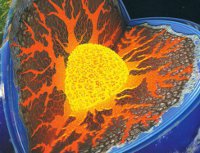Earth's core deceives scientists
Scientists have virtually denied the existing hypothesis about the formation of the Earth's core. It was believed that the metal core of all celestial bodies is formed under the same scheme. However, recent experiments demonstrated that there are other ways to form the core. It turns out that this process should be seen as unique to each celestial body.

Scientists base the hypotheses of formation of the mantle and the core of our planet on the composition of the two layers. Looking at the structure of the mantle, we can see that the closest to the Earth's crust is a layer of molten magma. At a depth of three thousand miles the mantle becomes solid or as geologists joke, "ceramic," as it is mainly composed of oxygen, silicon and magnesium with small additions of iron.
Interestingly, the core has a similar structure. Its top layer is liquid, and under it, at the very center of the planet, there is the hard part of the nucleus. But the chemical composition of this layer of the Earth is very different. Nearly the entire core is composed of iron and related metals. There is a legitimate question - how at the dawn of the formation of our planet almost all of the iron has managed to concentrate in the core? This element could not leak through the solid "ceramic" mantle that makes up a large part of our planet.
This is supported by numerous laboratory experiments with mixtures of silicate minerals and iron. The latter is always present in the formation in the form of tiny isolated structures trapped at the joints between minerals grains. It cannot escape at ordinary temperature and pressure. Therefore, the scientists had no choice but to assume that the mass "lowering" of iron in the center of the planet was only possible in the early stages of the Earth's development, when the temperature in it was so high that the upper part of the "ceramic" mantle completely melted. Thus, iron droplets could seep through the mantle and collect at its base, and then under the effect of gravity sank further. This is how the core was ultimately formed.
Until now, this theory of the vertical stratification of the Earth was supported by the majority of scholars, but recently some of them proposed to revise this model. It all started after a series of studies led by Professor Wendy Mao of Stanford University (USA). They have been studying the process of eliminating iron from silicates that occurs at a depth of 1,000 kilometers from the Earth surface in the part of the mantle that is sufficiently hard.
The researchers conducted a series of experiments in which they studied the behavior of minerals in the samples that were under extreme pressure and temperature between the tips of the diamond crystals. As a result, they found that when the pressure inside the mantle increases, liquid iron begins wetting the surface of the silicate minerals grains. This results on the flows of molten iron gathering into streams in the solid mantle (this process is called percolation). Having carefully studied the conditions of this process, scientists have found that it can occur even when the mantle is hot enough to form an entire "ocean" of magma through which iron quietly slips into the core.
The lead scientist Dr. Mao commented that for the percolation to be effective, the molten iron has to lay continuous channels through the firm area. This was thought to be impossible, but now we know that under certain conditions known to have existed on the planet it can happen.
Many colleagues of the Stanford geophysicist immediately appreciated the value of this research. Dr. Geoffrey Bromiley with the University of Edinburgh (UK) said that the new data from the group of Professor Mao indicate that the formation of the core was not a simple, single-stage event. He added that this complex process must have had a no less complex effect on the subsequent chemistry of the Earth.
He believes that this study raises important questions about the beginning of the formation of the planet's core. According to the generally accepted theory, the study of meteorites and asteroids' cores will be able to tell us about our own planet, but according to Dr. Bromiley, a discovery made by Professor Mao and her colleagues found that the formation of each core of a large planet is a unique process. If the findings of the scientists are correct, this means that the immersion of iron in the core could proceed quite intensively during the cooling of the Earth as well. This is impossible for small celestial bodies that have a mantle of lower weight and a different chemical composition.
However, Dr. Bromiley suggested that the process of formation of the nucleus could be influenced by other factors. For example, it could be a collision of the Earth in the early stages of its development with asteroids and other heavenly bodies. He added that at this time scientists who study this process had more questions than answers.
The scientist said that the metal core in celestial bodies significantly smaller than the Earth was seen rather frequently. He is unsure of the processes of the core formation in these bodies because they have never been large enough to allow for the percolation. So far, there is no answer to this question, but it is not ruled out that it will be revealed in the near future.
Anton Evseev
Pravda.Ru
Subscribe to Pravda.Ru Telegram channel, Facebook, RSS!


